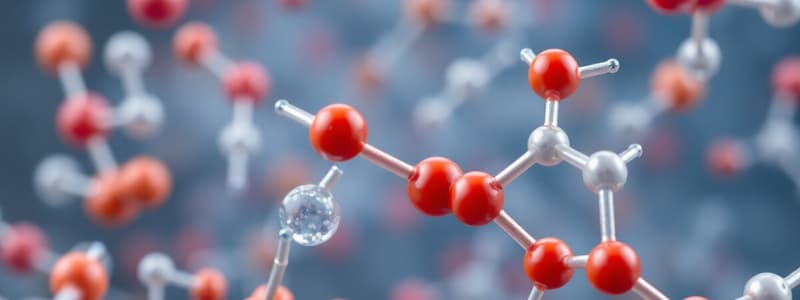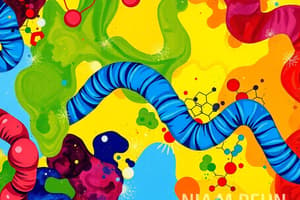Podcast
Questions and Answers
Aspartame, an artificial dipeptide sweetener containing phenylalanine, carries a warning for phenylketonurics. Which characteristic BEST describes phenylalanine?
Aspartame, an artificial dipeptide sweetener containing phenylalanine, carries a warning for phenylketonurics. Which characteristic BEST describes phenylalanine?
- Contains a sulfhydryl group
- An aromatic amino acid (correct)
- A dietary nonessential amino acid
- Contains a hydroxyl group
GABA, a neurotransmitter, is formed by decarboxylation of an amino acid's alpha-carboxyl group. Which amino acid is MOST likely the precursor to GABA?
GABA, a neurotransmitter, is formed by decarboxylation of an amino acid's alpha-carboxyl group. Which amino acid is MOST likely the precursor to GABA?
- Tryptophan
- Glycine
- Glutamate (correct)
- Aspartate
An enzyme involved in intermediary metabolism contains alpha-helices. Which statement BEST describes the alpha-helical secondary structure?
An enzyme involved in intermediary metabolism contains alpha-helices. Which statement BEST describes the alpha-helical secondary structure?
- A structure favored by a high amount of proline residues
- Stabilized by phosphodiester linkages
- Stabilized by peptide bonds alone
- Contains amino acids with their side chains towards the outside of the helix (correct)
A research group studies covalent bonds in the tertiary structure of proteins. Which bond are they MOST likely studying?
A research group studies covalent bonds in the tertiary structure of proteins. Which bond are they MOST likely studying?
In E. coli, glucose is converted to chorismate, an intermediate in the synthesis of histidine, phenylalanine, tyrosine, and tryptophan. Which of the following statements BEST describes gene expression for tryptophan synthesis in these bacteria?
In E. coli, glucose is converted to chorismate, an intermediate in the synthesis of histidine, phenylalanine, tyrosine, and tryptophan. Which of the following statements BEST describes gene expression for tryptophan synthesis in these bacteria?
During translation, a tRNA molecule interacts with mRNA. If the positions of nucleotides in the tRNA and mRNA are numbered sequentially, which position on the tRNA best indicates the location of the first nucleotide of the anticodon?
During translation, a tRNA molecule interacts with mRNA. If the positions of nucleotides in the tRNA and mRNA are numbered sequentially, which position on the tRNA best indicates the location of the first nucleotide of the anticodon?
A research laboratory studies a disease-causing gene leading to loss of enzyme function. Karyotyping and DNA microarray show no chromosomal changes. Northern blot analysis shows normal mRNA transcript levels. Western blot shows a smaller protein. Which mutation is most consistent with these findings?
A research laboratory studies a disease-causing gene leading to loss of enzyme function. Karyotyping and DNA microarray show no chromosomal changes. Northern blot analysis shows normal mRNA transcript levels. Western blot shows a smaller protein. Which mutation is most consistent with these findings?
Insulin undergoes modification after synthesis. The primary insulin translation product is modified to produce the mature hormone. Which modification is most likely observed during this process?
Insulin undergoes modification after synthesis. The primary insulin translation product is modified to produce the mature hormone. Which modification is most likely observed during this process?
A bacterial strain has reduced translation rates due to decreased activity in peptide bond formation; this inhibits ribosomal protein synthesis. A mutation in which of the following is most consistent with these findings?
A bacterial strain has reduced translation rates due to decreased activity in peptide bond formation; this inhibits ribosomal protein synthesis. A mutation in which of the following is most consistent with these findings?
A mutation in the gene encoding aminoacyl-tRNA synthetase would directly affect which of the following processes?
A mutation in the gene encoding aminoacyl-tRNA synthetase would directly affect which of the following processes?
A researcher introduces a mutation into the gene for a prokaryotic ribosomal protein. This mutation specifically impairs the ability of the ribosome to bind mRNA. Where is the most likely location of this mutation?
A researcher introduces a mutation into the gene for a prokaryotic ribosomal protein. This mutation specifically impairs the ability of the ribosome to bind mRNA. Where is the most likely location of this mutation?
Which of the following is NOT a typical modification that occurs to eukaryotic proteins after translation?
Which of the following is NOT a typical modification that occurs to eukaryotic proteins after translation?
When the anticodon of a tRNA base pairs with the codon of an mRNA, what is the orientation of their directionality?
When the anticodon of a tRNA base pairs with the codon of an mRNA, what is the orientation of their directionality?
A lab observes a disease-causing gene exhibiting a loss of enzyme function. Karyotyping and DNA microarray reveal an unchanged chromosome structure. Northern blot analysis shows no change in mRNA transcript levels, but Western blot analysis indicates a smaller than normal protein. Which mutation is most likely responsible?
A lab observes a disease-causing gene exhibiting a loss of enzyme function. Karyotyping and DNA microarray reveal an unchanged chromosome structure. Northern blot analysis shows no change in mRNA transcript levels, but Western blot analysis indicates a smaller than normal protein. Which mutation is most likely responsible?
An insertion of 'GCG' into an exon of a gene will most likely result in which outcome?
An insertion of 'GCG' into an exon of a gene will most likely result in which outcome?
If the codon 'CCC' is mutated to 'CCG', what is the most likely consequence?
If the codon 'CCC' is mutated to 'CCG', what is the most likely consequence?
What is the most likely outcome of a splice site mutation?
What is the most likely outcome of a splice site mutation?
A 99% reduction in promoter function will most likely lead to which of the following?
A 99% reduction in promoter function will most likely lead to which of the following?
If a western blot shows a smaller than normal protein, and a northern blot shows no change in mRNA transcript of the gene, what can you conclude?
If a western blot shows a smaller than normal protein, and a northern blot shows no change in mRNA transcript of the gene, what can you conclude?
In a scenario where a disease-causing gene shows no change in chromosome structure or mRNA transcript but produces a smaller protein, which mutation is least likely?
In a scenario where a disease-causing gene shows no change in chromosome structure or mRNA transcript but produces a smaller protein, which mutation is least likely?
What event is crucial for ribosome function on a polycistronic mRNA during bacterial translation?
What event is crucial for ribosome function on a polycistronic mRNA during bacterial translation?
In the context of bacterial translation involving polycistronic mRNA, which statement accurately characterises the initiation process at AUG codons?
In the context of bacterial translation involving polycistronic mRNA, which statement accurately characterises the initiation process at AUG codons?
What type of post-translational modification is most likely observed during the maturation of insulin from its primary translation product?
What type of post-translational modification is most likely observed during the maturation of insulin from its primary translation product?
During translation, a researcher observes that multiple proteins are being produced from a single mRNA molecule in a bacterial cell. Which of the statements below is the likeliest explanation?
During translation, a researcher observes that multiple proteins are being produced from a single mRNA molecule in a bacterial cell. Which of the statements below is the likeliest explanation?
A bacterial strain exhibits reduced rates of translation due to decreased activity in peptide bond formation. A mutation in which component is most consistent with these findings?
A bacterial strain exhibits reduced rates of translation due to decreased activity in peptide bond formation. A mutation in which component is most consistent with these findings?
Which modification does NOT occur post-translationally in eukaryotes?
Which modification does NOT occur post-translationally in eukaryotes?
Considering the structure and function of tRNA in translation, which position corresponds to the first nucleotide of the anticodon that interacts with the mRNA codon?
Considering the structure and function of tRNA in translation, which position corresponds to the first nucleotide of the anticodon that interacts with the mRNA codon?
A researcher observes that a newly synthesized pre-proinsulin molecule is not being correctly processed into mature insulin. Which of the following is LEAST likely to be the cause?
A researcher observes that a newly synthesized pre-proinsulin molecule is not being correctly processed into mature insulin. Which of the following is LEAST likely to be the cause?
A scientist mutates a bacterial gene, resulting in the production of a non-functional enzyme. Further analysis reveals that the mRNA transcribed from the mutated gene is polycistronic, but only the first protein in the cistron is produced. What is the most likely cause of this?
A scientist mutates a bacterial gene, resulting in the production of a non-functional enzyme. Further analysis reveals that the mRNA transcribed from the mutated gene is polycistronic, but only the first protein in the cistron is produced. What is the most likely cause of this?
Which of the given options, is a direct participant in the recognition and alignment of mRNA on the ribosome during translation in prokaryotes?
Which of the given options, is a direct participant in the recognition and alignment of mRNA on the ribosome during translation in prokaryotes?
A researcher discovers a new bacterial species with a unique translation mechanism. The mRNA produced is polycistronic, but unlike other bacteria, each protein in the cistron is produced in equal amounts, regardless of its position in the mRNA. Which of the following would best explain this observation?
A researcher discovers a new bacterial species with a unique translation mechanism. The mRNA produced is polycistronic, but unlike other bacteria, each protein in the cistron is produced in equal amounts, regardless of its position in the mRNA. Which of the following would best explain this observation?
A researcher is studying a protein that requires glycosylation to be fully functional. Where would this process occur?
A researcher is studying a protein that requires glycosylation to be fully functional. Where would this process occur?
What is the function of the start codon AUG in eukaryotic protein synthesis?
What is the function of the start codon AUG in eukaryotic protein synthesis?
During translation, where does the amino acid bind to the tRNA?
During translation, where does the amino acid bind to the tRNA?
Which of the following antibiotics primarily inhibits the translocation step of translation in bacteria?
Which of the following antibiotics primarily inhibits the translocation step of translation in bacteria?
During the nomenclature of a nucleic acid, how is the order in which it's named described?
During the nomenclature of a nucleic acid, how is the order in which it's named described?
Which of the given options is NOT required to achieve the elongation step in prokaryotic translation?
Which of the given options is NOT required to achieve the elongation step in prokaryotic translation?
Which of the following mutations is MOST likely to result in a protein that is produced in normal amounts but fails to be secreted from the cell?
Which of the following mutations is MOST likely to result in a protein that is produced in normal amounts but fails to be secreted from the cell?
Which of the following drugs inhibits bacterial DNA replication?
Which of the following drugs inhibits bacterial DNA replication?
What is the target of rifamycin?
What is the target of rifamycin?
Which eukaryotic translation inhibitor targets peptidyl transferase activity?
Which eukaryotic translation inhibitor targets peptidyl transferase activity?
Which of the following drugs is classified as a nucleoside analog and inhibits DNA replication?
Which of the following drugs is classified as a nucleoside analog and inhibits DNA replication?
Which of the following drugs inhibits eukaryotic RNA polymerase II?
Which of the following drugs inhibits eukaryotic RNA polymerase II?
Which of the following antibiotics inhibits the aminoacyl tRNA entry into the A site of the ribosome?
Which of the following antibiotics inhibits the aminoacyl tRNA entry into the A site of the ribosome?
Flashcards
Aspartame
Aspartame
An artificial dipeptide sweetener that includes phenylalanine.
Phenylalanine
Phenylalanine
An aromatic amino acid found in aspartame.
GABA precursor
GABA precursor
Glutamate is the amino acid that forms GABA through decarboxylation.
Alpha-helix
Alpha-helix
Signup and view all the flashcards
Covalent bonds in proteins
Covalent bonds in proteins
Signup and view all the flashcards
Disulfide bonds
Disulfide bonds
Signup and view all the flashcards
Chorismate
Chorismate
Signup and view all the flashcards
Gene expression in E.coli
Gene expression in E.coli
Signup and view all the flashcards
mRNA and enzyme production
mRNA and enzyme production
Signup and view all the flashcards
Post-translational processing
Post-translational processing
Signup and view all the flashcards
Start codon recognition
Start codon recognition
Signup and view all the flashcards
Formyl-methionine in translation
Formyl-methionine in translation
Signup and view all the flashcards
Anticodon first nucleotide
Anticodon first nucleotide
Signup and view all the flashcards
Mutation impact on enzyme function
Mutation impact on enzyme function
Signup and view all the flashcards
Insulin modification after synthesis
Insulin modification after synthesis
Signup and view all the flashcards
Peptide bond formation mutation
Peptide bond formation mutation
Signup and view all the flashcards
Antiparallel arrangement
Antiparallel arrangement
Signup and view all the flashcards
Mutation types
Mutation types
Signup and view all the flashcards
Insertion mutation
Insertion mutation
Signup and view all the flashcards
Frameshift mutation
Frameshift mutation
Signup and view all the flashcards
Silent mutation
Silent mutation
Signup and view all the flashcards
Splice site mutation
Splice site mutation
Signup and view all the flashcards
Promoter function reduction
Promoter function reduction
Signup and view all the flashcards
Western blot analysis
Western blot analysis
Signup and view all the flashcards
Polycistronic mRNA
Polycistronic mRNA
Signup and view all the flashcards
Internal AUG codons
Internal AUG codons
Signup and view all the flashcards
Formyl-methionine
Formyl-methionine
Signup and view all the flashcards
Introns
Introns
Signup and view all the flashcards
Anticodon
Anticodon
Signup and view all the flashcards
Wobble position
Wobble position
Signup and view all the flashcards
Nucleic acid naming convention
Nucleic acid naming convention
Signup and view all the flashcards
Mature insulin formation
Mature insulin formation
Signup and view all the flashcards
Post-translational modification
Post-translational modification
Signup and view all the flashcards
Hydrolytic cleavage
Hydrolytic cleavage
Signup and view all the flashcards
Peptidyl transferase activity
Peptidyl transferase activity
Signup and view all the flashcards
Ribosomal RNA
Ribosomal RNA
Signup and view all the flashcards
Insulin glycosylation
Insulin glycosylation
Signup and view all the flashcards
Signal peptide removal
Signal peptide removal
Signup and view all the flashcards
Shine-Dalgarno sequence
Shine-Dalgarno sequence
Signup and view all the flashcards
Erythromycin mechanism
Erythromycin mechanism
Signup and view all the flashcards
Bacterial translation inhibitors
Bacterial translation inhibitors
Signup and view all the flashcards
Chloramphenicol action
Chloramphenicol action
Signup and view all the flashcards
Cycloheximide role
Cycloheximide role
Signup and view all the flashcards
Streptomycin function
Streptomycin function
Signup and view all the flashcards
Rifamycin function
Rifamycin function
Signup and view all the flashcards
Eukaryotic transcription inhibitors
Eukaryotic transcription inhibitors
Signup and view all the flashcards
Nucleoside analogs
Nucleoside analogs
Signup and view all the flashcards
Study Notes
Amino Acids and Proteins - Practice Questions
- Aspartame and Phenylketonurics: Aspartame, an artificial dipeptide sweetener, contains phenylalanine. Phenylketonurics should avoid aspartame. Phenylalanine is characterized as an aromatic amino acid.
- GABA Precursor: GABA (gamma-aminobutyric acid) is a neurotransmitter formed by the decarboxylation of glutamate's alpha-carboxyl group.
- Enzyme Secondary Structure: Enzymes with alpha-helices in their secondary structure are stabilized by hydrogen bonds, with side chains projecting outward. Proline residues do not favor this structure.
- Covalent Bonds in Tertiary Structure: Covalent bonds, specifically disulfide bonds formed between cysteine residues, are found in the tertiary structure of proteins.
- E. coli Metabolism and Gene Expression: Glucose metabolism leads to chorismate, a precursor to histidine, phenylalanine, tyrosine, and tryptophan biosynthesis. If tryptophan is needed, a single mRNA containing instructions for all five enzymes is produced.
- tRNA Anticodon Position: Position 5 on the tRNA diagram displayed, typically indicates the nucleotide that starts the anticodon.
Translation and RNA - Practice Questions
- AUG Start Codon: The AUG codon, found in mRNA, is generally the start site of protein synthesis, but not all AUG codons are start codons. Formyl-methionine is incorporated into the polypeptide at the AUG start codon.
- Martian Genetic Code Differences: The code for the amino acids in Martian microorganisms' genetic code may vary from the terrestrial genetic code.
- Mutations and Protein Size: Small insertion mutations into an exon may affect the chromosome, mRNA and ultimately protein, size. The protein products will likely be shorter than in the normal form.
- Insulin Modifications: Insulin is modified after synthesis, including the cleavage of specific peptide bonds. This process is not glycosylation.
- Ribosomal Protein Synthesis Inhibition: Mutations in ribosomal proteins, ribosomal RNA and EF-Tu protein can disrupt translation.
Additional Practice Questions
- Protein Synthesis: Concept maps in the biochemistry textbook for this topic are important study references. Specific questions on amino acids, protein structure and protein synthesis are recommended for studying.
- Genetic Mutations and Proteins: Small gene mutations can have major effects on protein structure and function, resulting in shortened or lengthened proteins.
- Gene Expression Mechanisms: The use of specific mRNA messages that combine proteins for a pathway, rather then producing many mRNA segments is important in bacterial gene expression to simplify the process.
- Bacterial Translation Inhibitors: Erythromycin inhibits the translocation step in bacterial protein synthesis, while other inhibitors have different mechanisms.
Studying That Suits You
Use AI to generate personalized quizzes and flashcards to suit your learning preferences.




